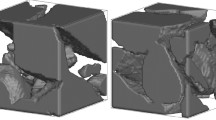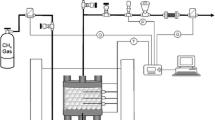Abstract
The formation of sub-seafloor gas hydrates in marine environments can be described as a coupled transport and thermodynamic process inside a host sediment matrix undergoing structural evolution. The transport processes are driven by the sedimentary load and induced overpressure gradients, controlled by sediment permeability. In order to accurately model the resulting fluid flow profile, the decrease of sediment permeability during hydrate precipitation has to be taken into account, which affects both the transport of solutes and sediment compaction. In this paper, we investigate how total hydrate abundance is affected by regions of low permeability which deflect the flow field in their vicinity. For this purpose, a two-dimensional numerical hydrate system model was set up which permits to quantify this effect in scenarios where changes in water depth cause lateral variations of the thickness of the hydrate stability field, as well as of hydrate saturation and sediment permeability. The microscopic structure of gas hydrate crystals in the host sediment matrix defines the evolution of the permeability reduction during hydrate formation. Grain-coating precipitates have a stronger tendency to clog flow paths through pore throats than do pore-filling precipitates. Our results clearly show that these pore-scale processes affect the large-scale flow field and hydrate abundance. The sensitivity depends on the model geometry and, for a 5° slope of the seafloor, 4.1% relative difference is predicted for the hydrate saturation according to different porosity-permeability relationships.







Similar content being viewed by others
References
Bear J (1988) Dynamics of fluids in porous media. Dover, New York
Buffett BA, Zatsepina OY (2000) Formation of gas hydrate from dissolved gas in natural porous media. Mar Geol 164:69–77
Carman PC (1956) Flow of gases through porous media. Academic, New York
Clennell BM, Hovland M, Booth JS, Henry P, Winters WJ (1999) Formation of natural gas hydrates in marine sediments. 1. Conceptual model of gas hydrate growth conditioned by host sediment properties. J Geophys Res 104:22985–23003
Darcy H (1856) Les fontaines publiques de la ville de Dijon. Dalmont, Paris
Davie MK, Buffett BA (2001) A numerical model for the formation of gas hydrate below the seafloor. J Geophys Res-Solid Earth 106:497–514
Hantschel T (2008) Fundamentals of basin and petroleum systems modeling. Springer, Berlin
Kleinberg RL, Flaum C, Griffin DD, Brewer PG, Malby GE, Peltzer ET, Yesinowski JP (2003) Deep sea NMR: methane hydrate growth habit in porous media and its relationship to hydraulic permeability, deposit accumulation, and submarine slope stability. J Geophys Res-Solid Earth 108(B10):2508. doi:10.1029/2003JB002389
Kvenvolden KA (1993) Gas hydrates—geological perspective and global change. Rev Geophys 31:173–187
Madden ME, Ulrich S, Szymcek P, McCallum S, Phelps T (2009) Experimental formation of massive hydrate deposits from accumulation of CH4 gas bubbles within synthetic and natural sediments. Mar Pet Geol 26:369–378
Pruess K, Oldenburg CM, Moridis G (1999) TOUGH2 User’s guide, Version 2.0. Lawrence Berkeley National Laboratory Rep LBNL-43134
Shampine LF, Reichelt MW (1997) The MATLAB ODE suite. Siam J Sci Computing 18:1–22
Sloan ED (1998) Clathrate hydrates of natural gases. Dekker, New York
Vaughan PJ (1987) Analysis of permeability reduction during flow of heated, aqueous fluid through Westerly Granite. In: Tsang CF (ed) Coupled processes associated with nuclear waste repositories. Academic, New York, pp 529–539
Verma A, Pruess K (1988) Thermohydrological conditions and silica redistribution near high-level nuclear wastes emplaced in saturated geological formations. J Geophys Res-Solid Earth Planets 93:1159–1173
Xu WY, Germanovich LN (2006) Excess pore pressure resulting from methane hydrate dissociation in marine sediments: a theoretical approach. J Geophys Res-Solid Earth 111:B01104. doi:10.1029/2004JB003600
Acknowledgements
This work is part of an ongoing PhD thesis which is partially funded by the International Research Consortium on Continental Margins (IRCCM). We gratefully acknowledge the support from an anonymous reviewer and the editor to improve the quality of this paper, which has greatly benefited from their detailed comments.
Author information
Authors and Affiliations
Corresponding author
Appendix
Appendix
The hydraulic equation in an evolving hydrate system
The coupled pressure and transport model for an evolving hydrate system requires the formulation of the hydraulic equation with fluid sources added from sediment compaction and methane phase transitions. As this complete formulation is not derived elsewhere, we append the calculation of the hydraulic overpressure from the continuity equations for fluid transport and sediment transport, relating pressure to transport velocities through Darcy’s Law.
For incompressible fluids and sediment grains, mass conservation requires
and
where hydrate dissociation can add a fluid source q f, while we assume no change (q s = 0) of solid material through diagenetic processes. S w is the water fraction of the pore space, and v f and v s are the intrinsic fluid and sediment velocity respectively.
We now rearrange Eq. 4 into
and apply Darcy’s Law to relate the filtration rate \( {{\mathbf{u}}_{\text{D}}} = {S_{\text{w}}}\phi \left( {{{\mathbf{v}}_{\text{f}}} - {{\mathbf{v}}_{\text{s}}}} \right) \) to the overpressure \( p\prime = p - {p^{\text{h}}} \) at the permeability κ and viscosity ν,
both of which inserted into Eq. 3 gives
where we made use of the material derivative defined as
The change in porosity is related to the sediment compressibility C by
where σ is the effective stress, and p h and p 1 are the hydrostatic and lithostatic pressure respectively.
If we assume that only vertical stress and solid material transport occurs \( \left( {{{\mathbf{v}}_{\text{s}}} = {v_{{\text{s,z}}}}{{\hat e}_{\text{z}}}} \right) \), then the compressibility is calculated as
and the lithostatic potential p 1−p h grows according to
with the gravitational acceleration g, and sediment and fluid density ρ s and ρ f.
Hydrate dissociation (formation)—most prevalent at the base (top) of the hydrate zone—represents a fluid source (sink) equivalent to the released (fixed) amount of fresh water,
controlled by the expansion factor r g (Xu and Germanovich 2006).
Finally, we substitute S w=1−S h−S g, as the water, hydrate fraction S h and gas fraction S g occupy the total pore space, and the basic equation for the hydraulic overpressure p′ follows when Eqs. 7, 9 and 10 are substituted into Eq. 5:
Rights and permissions
About this article
Cite this article
Hauschildt, J., Unnithan, V. & Vogt, J. Numerical studies of gas hydrate systems: sensitivity to porosity-permeability models. Geo-Mar Lett 30, 305–312 (2010). https://doi.org/10.1007/s00367-009-0177-z
Received:
Accepted:
Published:
Issue Date:
DOI: https://doi.org/10.1007/s00367-009-0177-z




